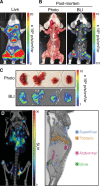Enhanced noninvasive imaging of oncology models using the NIS reporter gene and bioluminescence imaging
- PMID: 30674994
- PMCID: PMC7170803
- DOI: 10.1038/s41417-019-0081-2
Enhanced noninvasive imaging of oncology models using the NIS reporter gene and bioluminescence imaging
Abstract
Noninvasive bioluminescence imaging (BLI) of luciferase-expressing tumor cells has advanced pre-clinical evaluation of cancer therapies. Yet despite its successes, BLI is limited by poor spatial resolution and signal penetration, making it unusable for deep tissue or large animal imaging and preventing precise anatomical localization or signal quantification. To refine pre-clinical BLI methods and circumvent these limitations, we compared and ultimately combined BLI with tomographic, quantitative imaging of the sodium iodide symporter (NIS). To this end, we generated tumor cell lines expressing luciferase, NIS, or both reporters, and established tumor models in mice. BLI provided sensitive early detection of tumors and relatively easy monitoring of disease progression. However, spatial resolution was poor, and as the tumors grew, deep thoracic tumor signals were massked by overwhelming surface signals from superficial tumors. In contrast, NIS-expressing tumors were readily distinguished and precisely localized at all tissue depths by positron emission tomography (PET) or single photon emission computed tomography (SPECT) imaging. Furthermore, radiotracer uptake for each tumor could be quantitated noninvasively. Ultimately, combining BLI and NIS imaging represented a significant enhancement over traditional BLI, providing more information about tumor size and location. This combined imaging approach should facilitate comprehensive evaluation of tumor responses to given therapies.
Conflict of interest statement
RV, LS, KWP are employees of Imanis. KW, SJR, Imanis Life Sciences, and Mayo Clinic have a financial interest in the NIS technology used in this paper. The authors declare that they have no conflict of interest.
Figures





Similar articles
-
Cellular bioenergetics is an important determinant of the molecular imaging signal derived from luciferase and the sodium-iodide symporter.Circ Res. 2013 Feb 1;112(3):441-50. doi: 10.1161/CIRCRESAHA.112.273375. Epub 2012 Dec 19. Circ Res. 2013. PMID: 23255420 Free PMC article.
-
Dual reporter gene imaging for tracking macrophage migration using the human sodium iodide symporter and an enhanced firefly luciferase in a murine inflammation model.Mol Imaging Biol. 2013 Dec;15(6):703-12. doi: 10.1007/s11307-013-0645-8. Mol Imaging Biol. 2013. PMID: 23677652
-
Tracking of dendritic cell migration into lymph nodes using molecular imaging with sodium iodide symporter and enhanced firefly luciferase genes.Sci Rep. 2015 May 14;5:9865. doi: 10.1038/srep09865. Sci Rep. 2015. PMID: 25974752 Free PMC article.
-
The sodium iodide symporter (NIS) as an imaging reporter for gene, viral, and cell-based therapies.Curr Gene Ther. 2012 Feb 1;12(1):33-47. doi: 10.2174/156652312799789235. Curr Gene Ther. 2012. PMID: 22263922 Free PMC article. Review.
-
[18F]Tetrafluoroborate ([18F]TFB) and its analogs for PET imaging of the sodium/iodide symporter.Theranostics. 2018 Jun 24;8(14):3918-3931. doi: 10.7150/thno.24997. eCollection 2018. Theranostics. 2018. PMID: 30083270 Free PMC article. Review.
Cited by
-
Efficient radiolabeling of mesoporous silica nanoparticles for single-cell PET imaging.Eur J Nucl Med Mol Imaging. 2025 Apr;52(5):1778-1790. doi: 10.1007/s00259-024-07027-8. Epub 2024 Dec 27. Eur J Nucl Med Mol Imaging. 2025. PMID: 39729092
-
How Non-invasive in vivo Cell Tracking Supports the Development and Translation of Cancer Immunotherapies.Front Physiol. 2020 Apr 3;11:154. doi: 10.3389/fphys.2020.00154. eCollection 2020. Front Physiol. 2020. PMID: 32327996 Free PMC article. Review.
-
Spatiotemporal PET Imaging Reveals Differences in CAR-T Tumor Retention in Triple-Negative Breast Cancer Models.Mol Ther. 2020 Oct 7;28(10):2271-2285. doi: 10.1016/j.ymthe.2020.06.028. Epub 2020 Jun 27. Mol Ther. 2020. PMID: 32645298 Free PMC article.
-
A Novel CXCR4-Targeted Diphtheria Toxin Nanoparticle Inhibits Invasion and Metastatic Dissemination in a Head and Neck Squamous Cell Carcinoma Mouse Model.Pharmaceutics. 2022 Apr 18;14(4):887. doi: 10.3390/pharmaceutics14040887. Pharmaceutics. 2022. PMID: 35456719 Free PMC article.
-
Advances in preclinical evaluation of experimental antibody-drug conjugates.Cancer Drug Resist. 2021;4(4):745-754. doi: 10.20517/cdr.2021.37. Epub 2021 Jul 4. Cancer Drug Resist. 2021. PMID: 34532655 Free PMC article.
References
-
- Wang Y, Tseng JC, Sun Y, Beck AH, Kung AL. Noninvasive imaging of tumor burden and molecular pathways in mouse models of cancer. Cold Spring Harb Protoc. 2015;2015:135–44. - PubMed
-
- James ML, Gambhir SS. A molecular imaging primer: modalities, imaging agents, and applications. Physiol Rev. 2012;92:897–965. - PubMed
-
- O’Neill K, Lyons SK, Gallagher WM, Curran KM, Byrne AT. Bioluminescent imaging: a critical tool in pre-clinical oncology research. J Pathol. 2010;220:317–27. - PubMed
-
- Baker M. Whole-animal imaging: the whole picture. Nature. 2010;463:977–80. - PubMed
Publication types
MeSH terms
Substances
Grants and funding
LinkOut - more resources
Full Text Sources
Medical
Research Materials

